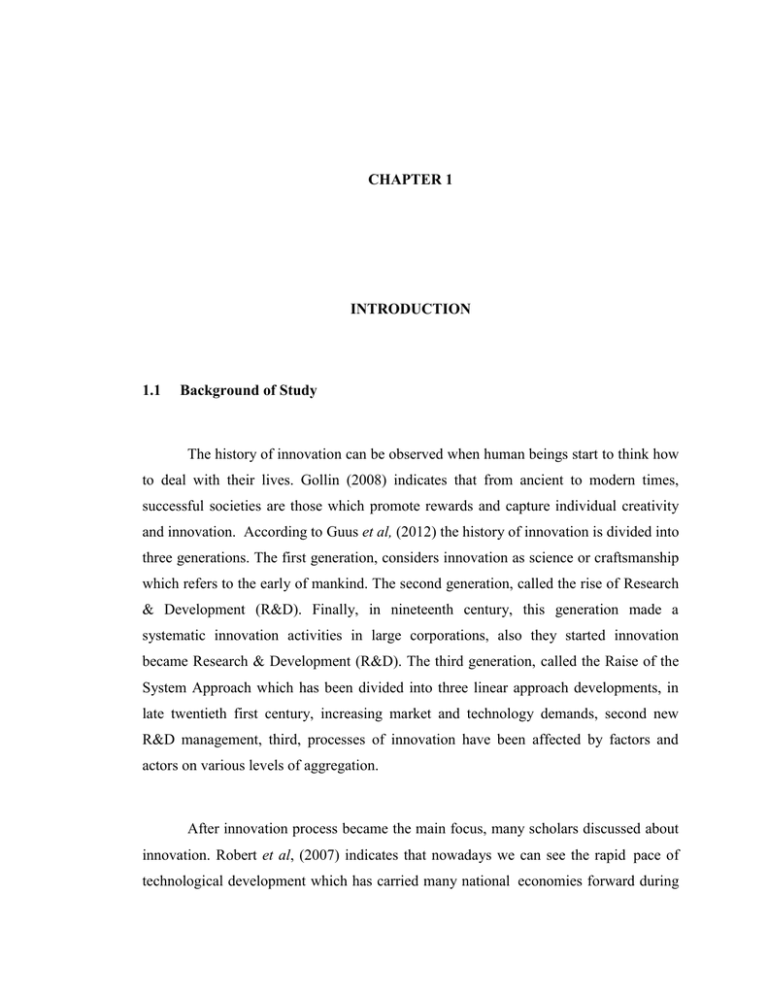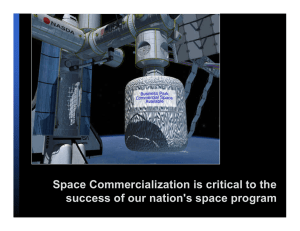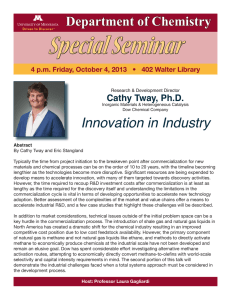Innovation Commercialization in Malaysian Universities: An Introduction
advertisement

CHAPTER 1 INTRODUCTION 1.1 Background of Study The history of innovation can be observed when human beings start to think how to deal with their lives. Gollin (2008) indicates that from ancient to modern times, successful societies are those which promote rewards and capture individual creativity and innovation. According to Guus et al, (2012) the history of innovation is divided into three generations. The first generation, considers innovation as science or craftsmanship which refers to the early of mankind. The second generation, called the rise of Research & Development (R&D). Finally, in nineteenth century, this generation made a systematic innovation activities in large corporations, also they started innovation became Research & Development (R&D). The third generation, called the Raise of the System Approach which has been divided into three linear approach developments, in late twentieth first century, increasing market and technology demands, second new R&D management, third, processes of innovation have been affected by factors and actors on various levels of aggregation. After innovation process became the main focus, many scholars discussed about innovation. Robert et al, (2007) indicates that nowadays we can see the rapid2pace of technological development which has carried many national2economies forward during 2 the past2200 years. Continuing the innovation which has been diffused through the2marketplace made this development possible. For instance, entrepreneurs have been an instrumental factor in the commercializing innovations, specifically radical or breakthrough2innovations such as: the airplane, automobile, personal computer. Since technologies have been growing more sophisticated and industries have become more2high-tech, as well as universities become more sufficient and an effective player in the processes of invention, innovation and commercialization. Commercialization in the university innovation became an important topic over two decades (Katherine, 2006). Commercialization can be described as the process by which inventions or latest technologies to become innovative or ready to market. For better understanding, the activities of commercialization provide the potential developments in the quality of life, by facilitating the access in industry to latest knowledge. A creative university leads to the availability on developed products and services. Meanwhile there are evidences which make commercialization of Research University to contribute to the national and regional growth of economic and international competitive2advantage. These outcomes of economy are extremely desirable for policy2makers because they represent the relatively direct benefit2arising from public investments in university research that can be usable for justifying those expenditures. Nowadays, the significance of universities and their2research development as well as commercialization (R, D & C) activities is widely recognized (Djokovic & Souitaris 2008). Previously, most of the universities were focusing on R&D, nonetheless, more recently there are many progressing shift towards the inclusion of2commercialisation activities. Collier and Gray (2010) defines commercialization as the character of the third mission, they also indicates that researchers in the universities produce innovations as a result for the research activities which reflects to be exploited commercially. However, the transformation from research and development to commercialization can be a path strewn2with many pitfalls. Nowadays studies on the 3 university research commercialization and the various models for university technology transfer are receiving more attention (Jolly, 2011; Siegel et al., 2003). Present research also desires to examine commercialization of the research output in Malaysian universities and it would attempt to explore notable factors affecting commercialization process. In Malaysia the exotic phrase, Vision 2020, has been coined to signify a lofty and long term objective, so as to be a fully developed nation by 2020 (Islam, 2009). However, Malaysian believed that some challenges would stand on the way of achieving the Vision 202. Also, the fundamental change is demanded, not only in economic and social performance, but also in the delivery of public goods and services that underpin the ability to develop the country. Whereby, as a result they committed themselves to a Government Transformation Programme (GTP). Foremost the Vision roadmap details the objectives, outcomes and the initial set of actions, as it has identified in the areas like Ministerial Key Result Areas (MKRAs) and National Key Result Areas (NKRAs). Meanwhile, parallel with National Economic Action Council (NEAC) which they formulating the New Economic Model, and the Economic Planning Unit (EPU) toward developing the Malaysia Plan. Both can be a roadmap and should be read together with this plan. Thus the government will focus on unlocking the growth and innovation potential of SMEs, creating domestic, regional and global champions as well as innovation and R&D infrastructure to be developed in areas with competitive advantage (Islam, 2009). In Malaysia there has been a limited study on commercializing the innovation activities, particularly in research universities. It is also realized that academic researchers are viewed as the critical process, question such as: what type of commercial research activities has appeared among academic researchers in Malaysian research universities are still open for research. Under the Tenth Malaysian Plan (MOHE, 2010) commercialization and innovation development has been assigned as niche by the Malaysian Ministry of Higher Education which implies the emphasis and urgency. The 4 aim of the Government of Malaysia is to encourage an environment where research and innovation will flourish. Innovation is the key importance in spurring economic growth in a developing country like Malaysia. The Government of Malaysia adheres to the principle that knowledge and ideas should be harnessed for wealth creation and societal well being. The traditional resource based economy is fast being replaced by knowledge based economy. Thus, Intellectual Property can become a key factor in driving this knowledge based economy into the future (MOHE, 2010). According to Malaysian Ministry of Science, Technology & Innovation their ninth recommendation has been accepted after the meeting with Prime Minister in 30th of November 2007 to transform Malaysia from the resource based to the innovation economy base through the National Innovation Model (NIM) (MOSTI Annual Report, 2012). National Innovation Model (NIM) has been described as the tool of balancing approaches between driven technology innovation and driven market innovation. In the model of driven technology innovation, scientists and researchers being funded for R&D, also technology will be improved fundamentally. Therefore, scientists and researchers eventually are commercializing their ideas to the international market. Meanwhile in the model of driven market innovation, the market has been determined before goes to the entrepreneur’s knowledge who can acquire the excellent technology and science. Foremost, Ministry of Science, Technology & Innovation (MOSTI Annual Report, 2012) mentioned Science, technology and innovation as the central of success in today's modern2economy. They also provide the Second National Science & Technology Policy as the framework for improving performance and Malaysian longterm economic growth. The aim of this policy is to: Raise the national capacity and capability to research and development (R&D), developing technology and acquisition. Encourage partnerships among industry and funded organizations. Place Malaysia as the technology provider to the strategic key and knowledge industries. 5 Enhance knowledge transformation to products, processes, services or solutions. Foster the values of the society and approaches that identify S&T as critical to future2prosperity, as well as the need of life-long learning. Ensure that S&T utilization can accords the emphasis through approaches on the conformity with sustainable2developmental goals. To progress the new knowledge based2industries. On top of that, Agensi Inovasi Malaysia built to assist Malaysian SMEs in moving up the value chain through innovation. AIM was established to stimulate and develop the innovation eco-system in Malaysia towards achieving the vision 2020. AIM also been established under the Prime Minister department apart of MOSTI. They plan to do this by providing opportunities for them to take advantage of innovation methodologies, policies and outcomes and complement the initiatives introduced by SME Corp. AIM’s role in this is to stimulate rapid new-wave wealth creation by commercializing research & development, as well as inventions and innovations that have been developed but not capitalized upon. Between the large corporations and the SMEs in Malaysia lie a number of companies that currently suffer from the “Middle Child” Syndrome. Unlike large companies that have the financial resources to take their business to another level, or the SMEs, these companies appear to be “stuck” as they do not know where to turn to for help and eventually flounder in a valley of stagnation. According to Aziz et al, (2011) Universiti Teknologi Malaysia (UTM) has the2highest number of commercialization output among Malaysia universities. They analyzed UTM commercialization infrastructure and procedures that can provide the blueprint for all Malaysian higher education’s and2institutes to follow. They also describe UTM context as an operator for providing an overview on commercialization environment towards research universities in Malaysia. Foremost, to indicate that blue print that presented as the background of university followed by the Universiti Teknologi Malaysia’s research, development and commercialization policies as well as structures. 6 1.2 Problem Statement Isabelle (2004) indicates that innovation and commercialization usually has been used to overlap methods in order to refer on the processes for discovering knowledge, technology development and converting all these to new process. She also mention commercialization is an ongoing process from mind and creativity to innovation and then to market. Meanwhile, adapt products and services as well as processes so as to be sold or compete in the market2place. Malaysian Government nowadays realized that they are trapped within the middle income plateau (NEM, 2010). However the requirements are to approach the developed status in 2020, while national progress and competitiveness can be charted against2innovation and not skills based performance. It has been clear that Malaysia need to shift their direction since late in nineties but it has been noticed that the progress was slow. This comes from some reasons such as: lacks of fully engaged2innovation ecosystem in the country, the education key components, ventures and industry which lead to entrepreneurial2activity, government. According to the Ministry of Science, Technology and Innovation, Intellectual Property Commercialization Policy (MOSTI Annual Report, 2009) in Malaysia, national policy cannot be seen in governing the commercialization and ownership of intellectual property in funding government projects. Therefore, it is necessary to formulate the single policy that would cover as much as possible the different situations to the common application by the government such as: government agencies and Research Institution, meanwhile providing funding to research, development as well as Commercialization purposes. That Intellectual Property Commercialization Policy is addressing these problems. Foremost, Ministry of Higher Education (MOHE, 2009) indicates that in Malaysia there is a sad paucity of innovative human capital (IHC) both in quantity and quality, and because of the important brain drain while concluded in the MOHE’s blueprint Agenda on Innovative Malaysian (AIM, 2009). 7 There are some studies has been done on commercializing the university innovation in Malaysia such Sudulah (2002) which he argued that the prospective collaborations among the universities and industries in Malaysia, the findings of survey which contained the indicators on the passiveness in Malaysian universities such as: the insufficiency on the innovative products toward commercialization, lack of researches on commercialization and lack convictions and commitment between academic staffs toward innovation and commercialization. Senin (2006) states the lack of funding in university industry and technology problems, lack of expertise and entrepreneurships, less commitment among academics, problems in institutions and limited linkage with industry. In Universiti Teknologi Malaysia some problems can be found firstly, funding on the process of innovation and commercialization. Second, the innovative products does not reach the market demand, there is timing mismatch, because the inventors will develop the product until prototype then patenting it and stop it. Meanwhile, most of the university inventers are focusing on patenting and publications but they claim that commercialization is not their job. Third, lack of convictions and commitment between university and industry is alarming. However, the decision makers have a significant impact on increasing the processes of commercialization and the culture in the university is strongly needed to be upgraded. University could be able to transform the knowledge from the laboratory toward commercially viable2products (Ismail, 2011). The above mentioned problems will make the products low quality of technology and low quality of commercialization rate. 8 1.3 Purpose of the Study The purpose of this research is to study the innovation and commercialization current process in Universiti Teknologi Malaysia so as to understand the main problems and issues which influences the university’s innovation and commercialization process. 1.4 Research Objective The objectives of this research are as follows: 1- To study the problems of innovation and commercialization process in Universiti Teknologi Malaysia. 2- To study the main factors that influences the university’s innovation and commercialization process. 3- To suggest the effective innovation and commercialization practice for Universiti Teknologi Malaysia. 1.5 Research Questions The questions of this research are as follows: 9 1- What is the current innovation and commercialization process in Universiti Teknologi Malaysia? 2- What are the main factors that influence the effectiveness of university’s current innovation and commercialization process? 1.6 Significance of the Study Base on the objectives above, the importance of this study is described. The finding and suggestions of this study will contribute to the existing knowledge which will be useful to university innovation process and other reader to further development on the factors that affect the innovation and commercialization process. According to the objective the use of this study are well described because it offers input to the university policy makers to provide a better trend and picture toward innovation and commercialization as well as identifying the influenced factors. However, by indicating the problems and being successful of providing a better process for innovation and commercialization is critically in need for Universiti Teknologi Malaysia in order to generate the income for the university’s management. Therefore, current study desires to investigate research commercialization operations at UTM. The findings of the study increase the body of knowledge on technology transfer and university commercialization particularly in UTM and generally in Malaysia. Furthermore the empirical of the study will provide suggestions to move the efforts to increase the commercialization of the innovative products, thus strengthen on the systematic understanding on the issue. Although, the concentration of this study on commercializing the university’s product differs from other fields due to the lengthy and 10 great development on patenting, commitment and collaboration in university. The findings of the study will be useful for the university. 1.7 Scope of the Study The study will focus on the current commercialization process and innovation in Universiti Teknologi Malaysia. The study also focuses on what are the factors that influence the university innovative process towards commercialization. The data collection for this study will focus on the interviewing among the Universiti Teknologi Malaysia’s inventors and Innovation & Commercialization Center’s staff. 1.8 Research Framework The framework of this study as it captured in (Figure 1.1) is stretched from Universiti Teknologi Malaysia as an exploratory study on the inventors and staffs of innovation towards commercialized products. After this, the study focused on the innovation issues listed in the framework which has lead to problems in innovation and towards commercialization. 11 Figure 1.1 Research Frameworks Motivations and commitment of inventors University support Funding Inventors / Researchers Innovation UTM ICC Innovation process Market research and Validation Market Driven Technology Commercialization 12 1.9 Research Layout Chapter 1 explanations in brief about the innovation and commercialization in general then leads elaborate more on about commercialization in Malaysian university specifically in Universiti Teknologi Malaysia and what are the problems faced in universities commercialization. Later the focus transmit on the components of the study; which contains the problem of statement, purpose of study, objective of the study, the research question and the significance of this study. The scope study was discussed, based on the university innovation towards commercialization. Chapter 2 starts with providing definition on the innovation and commercialization in overall. The chapter gives and explanation about the types of innovation bas on the Oslo Manual (2011). Besides, discussion on the relationships between innovation and commercialization was explored. After that the chapter gives another explanation on the problems of the innovation and commercialization process. The problem of commercialization consists; Motivation & Commitment of the Inventors, University Support and Funding, Innovation Process, Market Research & Market Validation and Market Driven Technology Chapter 3 discussed about the methodology employed, with particular attention paid to the qualitative approach, as well as data collection based on the semi-structured interview. On top of that, this chapter provides research design, population as well as the method which includes semi-structured interview and in-depth interview questions and data collection. Data analysis procedures of the above data are described in this chapter. Chapter 4 documented the findings of data analysis conducted on 16 of university inventors as well as the ICC staffs. Initially, the chapter starts with 13 background of the respondent and the data were analyzed based on the interview questions which were derived from the research objectives. Next some themes were extracted to cover the research objectives. Finally, seven significant themes were highlighted and these themes were chosen base on McKenna (1994) analysis. Chapter 5 discusses the results of the study base of the seven significant themes. Later in this chapter, reported on the discussion of the findings compared to literature review that presented in chapter 2. Next, the conclusion, recommendation and recommendation of this study are explained in detail. Ultimately this chapter presents recommendation of future potential research and contribution of this study has been made.




![Introduction [max 1 pg]](http://s3.studylib.net/store/data/007168054_1-d63441680c3a2b0b41ae7f89ed2aefb8-300x300.png)
